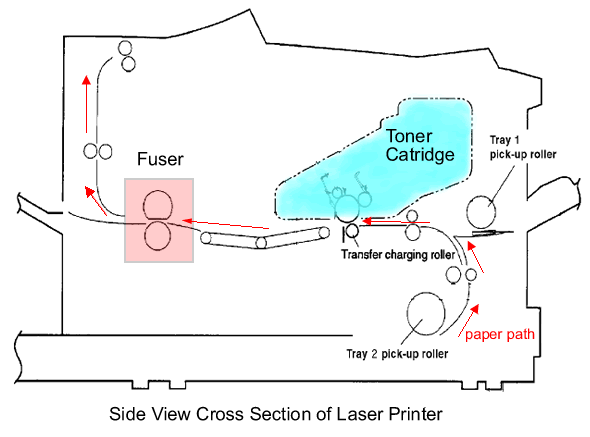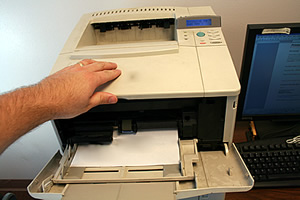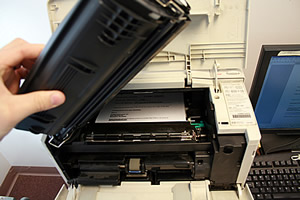The two most common sources of print defects are the toner cartridge and fuser. If you have a spare toner cartridge or fuser you can swap them to see if the problem goes away. Otherwise a half-way test is a simple method to determine where the print defect is occurring. As you can see in the diagram below, paper first travels under the toner cartridge and then into the fuser. This illustration is for black and white printers. Color printers are a bit more complex but the idea is the same: you want to interrupt printing right before the page gets to the fusing assembly.

The Half-way Test
You will need to print a page and open the toner lid when you think the paper is underneath the toner cartridge. This will stop the printing so you can pull the toner cartridge out and look at the partially printed paper. It may take a few tries to time this test correctly so the paper stops under the toner but not completely into the fuser.
| 1. Print a test page from Tray 1, the "fold-down" Multi-Purpose tray on your printer. | 2. Just as the test page completely disappears into the printer, open the toner lid door. The print job will stop, sensing an error. |
 |
 |
|
3. Pull the toner cartridge out, and you will find the test page sitting directly underneath the toner. |
4. Carefully remove the page by gently pulling the page upwards & free from the toner cavity. Careful! The toner has not yet been fused to the paper, so the print can be somewhat messy on your hands and may smudge easily. |
 |
 |
Examine the printout.
1. If you do not see the print defect on your test page, that means the defect is being added later in the print process by the fuser. Fusers are the main component in a maintenance kit; click here to view our selection of maintenance kits for various LaserJet printers.
2. If the print defect is visible on this printout, that means the print defect is occurring before the fuser. Try replacing the toner cartridge (click here to view our selection of toner cartridges).
If you determine the print defect is occurring before the fuser, and swapping toners doesn’t fix the problem, there could be several things causing the problem. In the order of most likely to least likely: you could have two defective toner cartridges, the transfer roller might be faulty, the laser scanner could be dirty or defective, or the high voltage power supply could be bad. You might want to email or call since these scenarios are not as common.




